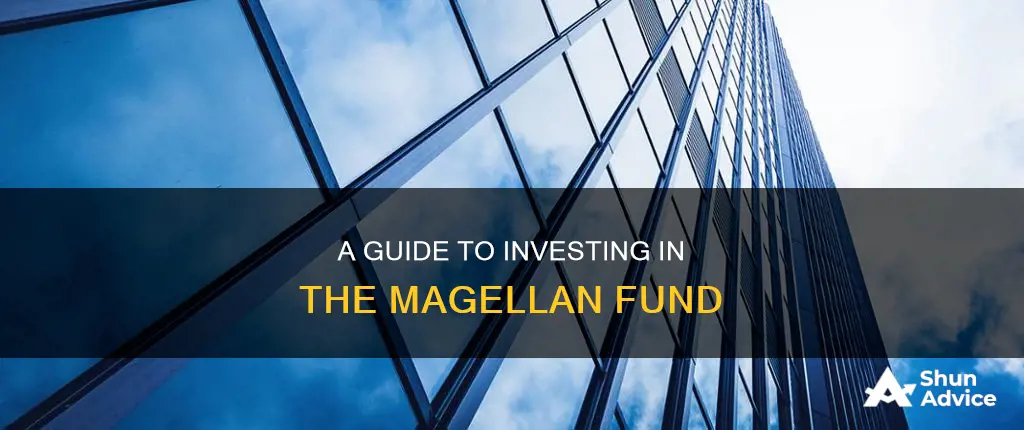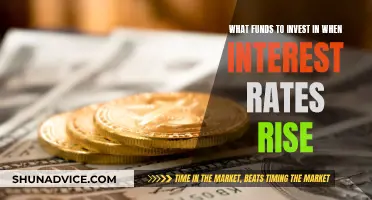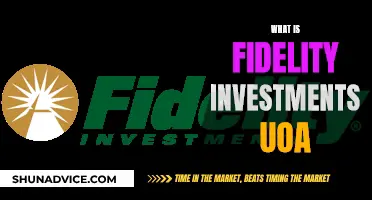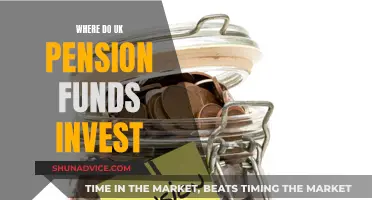
The Magellan Fund is a U.S.-domiciled mutual fund from the Fidelity family of funds. It is perhaps the world's best-known actively managed mutual fund, known for its record-setting growth under the management of Peter Lynch from 1977 to 1990. The fund earned an annualized return of 29.2% during Lynch's tenure, more than twice what the S&P 500 earned during that time. The fund had well over $100 billion in assets under management by the end of the 20th century and was the largest mutual fund in the world until 2000. So, how do you invest in the Magellan Fund?
What You'll Learn

The Magellan Fund's history
The Magellan Fund is perhaps the world's best-known actively managed mutual fund, known for its record-setting growth under the management of Peter Lynch from 1977 to 1990. The fund was established in 1963 but was only open to Fidelity insiders for the first 18 years of its life.
Under Lynch's management, the fund averaged over a 29% annual return, making Magellan the best-performing mutual fund in the world. Lynch's investment philosophy, "Buy What You Know", encouraged investors to invest in companies they are familiar with and understand so that they can develop reasonable expectations about the companies' growth potential and prospects. Lynch also popularized the idea of "Growth at a Reasonable Price" (GARP) and used the ratio PEG (PE ratio divided by per share growth rate) as a metric.
By the end of the 20th century, the Magellan Fund had well over $100 billion in assets under management. It was the single largest mutual fund in the world until April 2000, when it was overtaken by Vanguard's S&P 500 index fund.
After Lynch's tenure, the performance of the fund varied. Jeffrey Feingold, manager since September 2011, has successfully ridden the market uptrend and reversed the fund's poor performance under previous manager Harry Lange.
Retirement Funds: Risky Business for Long-Term Investors
You may want to see also

How to invest in the Magellan Fund
The Magellan Fund is a U.S.-domiciled mutual fund offered by Fidelity Investments. The fund was first established in 1963 but was only available to Fidelity insiders until the 1980s. Under the management of Peter Lynch from 1977 to 1990, the Magellan Fund grew from $20 million to $14 billion in assets under management and averaged an annual return of 29%.
If you are interested in investing in the Magellan Fund, here are the steps you can follow:
- Understand the Investment Objective and Strategy: Before investing, it is essential to understand the investment objective and strategy of the Magellan Fund. The fund aims to achieve attractive risk-adjusted returns over the medium to long term while reducing the risk of permanent capital loss. The fund typically invests in 20-40 of the world's best companies, focusing on those with a sustainable competitive advantage and long-term compound returns.
- Evaluate Your Investment Options: The Magellan Fund offers different investment options, including listed, quoted, and unlisted units. These units may be available on stock exchanges or through direct investment with the fund. Consider your investment preferences and the level of risk you are comfortable with before choosing an option.
- Meet the Investment Requirements: Different investment options may have specific requirements, such as minimum investment amounts or eligibility criteria. Make sure you review the prospectus or offering documents to understand the requirements for the investment option you choose.
- Open an Investment Account: To invest in the Magellan Fund, you will need to open an investment account. You can do this through Fidelity Investments or an authorized broker or financial institution. Provide the necessary information and documentation to open your account.
- Purchase Units of the Magellan Fund: Once your investment account is set up, you can purchase units of the Magellan Fund. You can typically do this through your online brokerage account or by contacting your financial advisor or broker. Specify the number of units you wish to purchase and provide funding for the investment.
- Monitor and Review Your Investment: After investing in the Magellan Fund, it is important to regularly monitor its performance and review your investment strategy. Stay updated with fund updates, annual reports, and market insights provided by Magellan and Fidelity. Evaluate whether the fund continues to meet your investment goals and make adjustments as necessary.
It is important to remember that investing carries risks, and the performance of the Magellan Fund may vary over time. Before investing, carefully consider your investment objectives, level of experience, and risk tolerance, and seek independent financial advice if needed.
Investing in Dementia Discovery: A Guide to the Dementia Discovery Fund
You may want to see also

The fund's investment strategy
The Funds Investment Strategy
The Magellan Financial Group, founded in 2006 and headquartered in Australia, is an active asset manager specialising in global equity and infrastructure strategies. The group focuses on investing in the world's best companies to grow and protect the wealth of its investors.
The group's investment strategy involves searching the world for high-quality companies that have a sustainable competitive advantage and will compound returns over the long term. This strategy is backed by rigorous research and a focus on creating long-term value for investors.
Magellan offers a disciplined approach to global investing and portfolio management, investing in 20-40 of the world's best companies to achieve attractive risk-adjusted returns over the medium to long term. The funds aim to deliver 9% per annum net of fees over the economic cycle while reducing the risk of permanent capital loss.
The investment funds are available in listed, quoted, and unlisted form, and foreign currency exposures can be hedged, unhedged, or at the discretion of the manager.
Magellan's investment strategy is also reflected in its infrastructure funds, which aim to deliver risk-adjusted returns over the medium to long term by investing in 20-40 high-quality global listed infrastructure companies.
The group's sustainable strategy involves investing in 20 to 50 high-quality global companies within a framework that considers ESG risks, aiming to achieve attractive risk-adjusted returns and preserve capital in adverse markets.
Overall, Magellan's investment strategy is centred around generating attractive risk-adjusted returns, investing in high-quality global companies, rigorous research, and a focus on long-term value creation.
Contrarian Macro Fund: An Alternative Investment Strategy
You may want to see also

The fund's performance
The Magellan Fund has had a varied performance history, with its success often closely tied to its manager at the time. Under Peter Lynch's management between 1977 and 1990, the fund averaged an impressive annual return of 29%, making it the best-performing mutual fund in the world during that period. Lynch's investment strategy, known as "Buy What You Know", encouraged investing in companies that were familiar and easy to understand, rather than relying solely on analyst reports. This approach, along with Lynch's focus on growth at a reasonable price (GARP), contributed to the fund's significant growth during his tenure.
However, after Lynch's departure, the fund's performance became more inconsistent. Morris Smith, who managed the fund from 1990 to 1992, beat the S&P 500 by 7%, but his conservative approach and decision to leave investing after his tenure led to a period of instability. Jeffrey Vinik, the next manager from 1992 to 1996, moved a large portion of the portfolio out of technology stocks and into bonds, causing Magellan to underperform its peers for the first time. Despite this, Vinik still produced an 83.70% cumulative return during his time at Magellan.
The following years saw a similar pattern, with Robert Stansky (1996-2005) delivering a return of 238% but underperforming the S&P 500, and Harry Lange (2005-2011) overseeing a significant drop in assets under management. Jeffrey Feingold, who took over in September 2011, has been credited with reversing the fund's poor performance and beating its benchmark. As of November 27, 2023, the fund had assets totaling almost $25.51 billion invested in 63 different holdings, primarily consisting of large-cap domestic stocks.
Overall, the Magellan Fund has had a mixed performance history, with periods of strong growth under managers like Peter Lynch and Jeffrey Vinik, followed by periods of underperformance relative to the market. The fund's performance has also evolved over the years, with some managers closely tracking the S&P 500 while others added more small and international stocks.
Short-Term Investment Strategies: Where to Park Your Money
You may want to see also

The fund's management
The Funds Management
The Magellan Fund is a U.S.-domiciled mutual fund from the Fidelity family of funds. It is perhaps the world's best-known actively managed mutual fund, known for its record-setting growth under the management of Peter Lynch from 1977 to 1990. The fund averaged over a 29% annual return during this period, making it the best-performing mutual fund in the world.
Under Peter Lynch, the fund grew from \$20 million to \$14 billion in assets under management (AUM). Lynch's investment strategy included selecting stocks from companies that he was familiar with and then evaluating their business models, competitive landscapes, growth potential, and more before investing. He also popularized the idea of "Growth at a Reasonable Price" (GARP) and created the price-to-earnings-growth (PEG) ratio, which helps investors determine whether a stock is inexpensive given its growth potential.
After Lynch's tenure, the performance of the fund varied. The fund was then managed by Morris Smith (1990-1992), Jeffrey Vinik (1992-1996), Robert Stansky (1996-2005), Harry Lange (2005-2011), and Jeffrey S. Feingold (2011-2020). During Stansky's tenure, the fund underperformed the market, marking the only regime where this occurred in the fund's history. Lange presided over the largest drop in assets under management, both in terms of percentage and absolute dollars. Feingold, the current manager, has successfully ridden the market uptrend and reversed the fund's poor performance under Lange. As of November 27, 2023, the fund has assets totaling almost $25.51 billion invested in 63 different holdings.
In addition to the U.S.-domiciled mutual fund, there is also a Magellan Financial Group based in Australia. This group offers a range of investment funds, including the Magellan Global Fund, the Magellan High Conviction Fund, the Magellan Core Global Fund, and the Airlie Australian Share Fund. These funds typically invest in 10-50 global companies and aim to achieve attractive risk-adjusted returns over the medium to long term while reducing the risk of permanent capital loss.
Investment Fund Balance Stagnation: Why It Happens
You may want to see also
Frequently asked questions
The Magellan Fund is a U.S.-domiciled mutual fund, part of the Fidelity family of funds. It is an actively managed fund, investing in global equities and infrastructure.
You can invest in the Magellan Fund by purchasing shares or units directly from the fund. You can also invest in the fund via the stock market, on the ASX or Cboe exchanges.
The minimum investment for the Magellan Fund is not stated, but it is likely to be accessible to most investors as it is a large, diversified fund.
As with any investment, there are risks involved. The fund carries the risk that large-cap domestic growth stocks will underperform other asset classes. Additionally, the active management of the fund may result in underperformance relative to the benchmark index.







